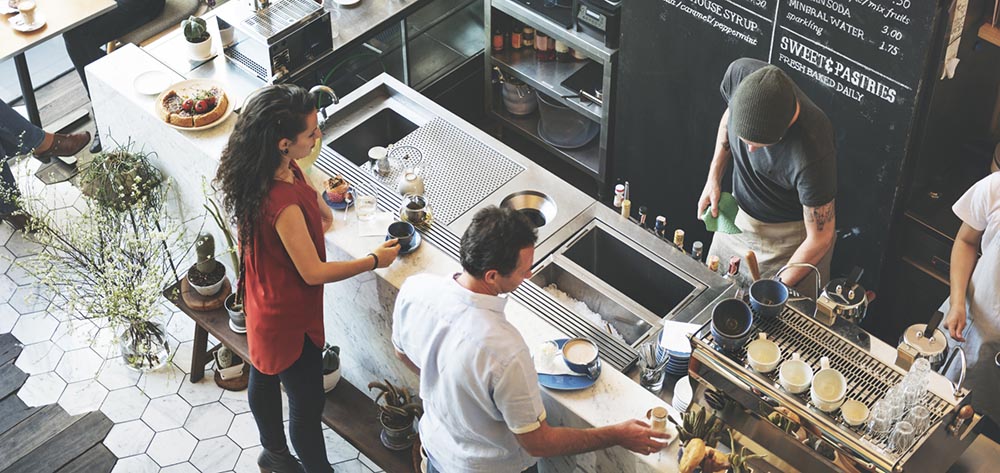As a coffee shop owner, you're not just focused on crafting the perfect latte. You’re also committed to ensuring the financial success and sustainability of your business. Central to this success: navigating taxes effectively and integrating sound financial planning into your business strategy.
Sound overwhelming?
Don’t worry. We’re here to help with information about how independent coffee shops like yours can handle taxes, optimize cash flow, and thrive in a competitive market.
From Deductions to Depreciation: How to Navigate the World of Taxes
Ben Franklin said nothing is certain except death and taxes. We’ll add tax confusion, myths, and misinformation to the list. Fortunately, with careful planning and strategic decisions (including tips like these), you can minimize tax liabilities and optimize your financial resources. (Ben would be pleased.)
Also consider seeking help from a tax (and financial) professional. Although it may cost you to seek professional help, it’s an investment that pays dividends in the long run as you find smarter ways to run your business and maximize your savings.
Giving Structure to Your Business
There’s no business like your business, but there are four main business structures that are universal to the world of business, each with their own advantages, tax implications, and protections:
- Sole proprietorship
- Partnership
- Corporation
- Limited liability company (LLC)
Want to know more? Check out LegalZoom’s article, then get down to business with a tax advisor to determine the best option for your coffee shop.
In addition, look into obtaining a Federal Tax Identification Number from the Internal Revenue Service. Also known as an Employer Identification Number (EIN), this number is used to identify a business entity and is necessary for tax reporting purposes if you have employees, operate as a corporation or partnership, file certain taxes, and more.

Getting the (Tax) Credit You Deserve
People talk about business deductions, but what are they–and where do tax credits come in?
Deductions are business expenses that reflect the cost of doing business.
Tax credits are amounts of money companies are allowed to deduct from the taxes they owe.
In short, while deductions reduce taxable income, credits are applied against taxes you owe and are applied when you file your tax return.
Here are tips to keep track of your business finances:
Keep (Good) Records: Tempted to keep all of your business-related expenses in a paper bag or stuffed in a cabinet? Don’t. Expenses like rent, utilities, supplies, equipment, and payroll are tax-deductible and can significantly reduce your taxable income–and should be closely tracked to maximize your savings. Consider using software for bookkeeping, such as Inquit Quickbooks, Freshbooks, Sage, Gusto, and more. These programs can automate the bulk of this work and integrate with many different systems.
Appreciate the Depreciation: Take advantage of depreciation deductions for equipment and property used in your coffee shop. Consult with a tax professional to determine the appropriate depreciation methods and schedules.
Discover the Benefits of Employee Benefits: As your business grows and becomes more stable, you may consider offering health insurance, retirement plans, and education assistance as part of your overall employee benefits package.These expenses are often tax-deductible and can help attract and retain top talent. It’s a great way to improve the health of your business, right along with that of your employees.
Complying with Sales Tax
All but five states have sales tax. If you’re in the 45 states that have it, make sure you’re in compliance.
Register for Sales Tax: First determine whether your state requires you to collect and remit sales tax on coffee and food sales. If they do, register with the appropriate state and local tax authorities to ensure compliance.
Report Sales Tax: Registering for sales tax is only half the job. You must also report it. Keep accurate records of sales tax collected and report and remit payments on time to avoid penalties and interest. If this feels too taxing or tedious, consider using accounting software or hiring a professional accountant to streamline this process.
Know the Exemptions: Tax exemptions can reduce your tax burden and improve cash flow. Research any available tax exemptions or incentives for small businesses in your area. Because when it comes to exemptions, more is more.
Financial Planning: the Other Half of the Success Coin
While managing taxes is essential, long-term financial success requires proactive planning and strategic decision-making. Here are some things to consider for your cafe.
Create (and Stick to) a Budget
Ah, yes. The B-word.
Although budgets sound onerous, they’re key to keeping spending in check. Develop a realistic budget that accounts for all expenses, including fixed costs (e.g., rent, utilities) and variable costs (e.g., inventory, staffing). Then monitor your actual spending against budgeted amounts regularly and make adjustments as needed. Wash. Rinse. Repeat.

Cash In on Cash Flow Management
Help ensure that you have money when–and where–you need it. Forecast to anticipate gains and shortfalls, and keep extra money on-hand (a.k.a. in the bank) to cover operating expenses, unforeseen emergencies, and seasonal fluctuations in revenue.
Strategize Your Pricing
There’s a hefty price to pay for those who don’t enact sound pricing strategies. Namely, the risk of overspending on items, overcharging customers out of the consideration set–or both.
To home in on the right strategy, start by conducting a thorough Cost Analysis to determine the true cost of each menu item, including ingredients, labor, and overhead. Set prices that not only cover costs but also generate a reasonable profit margin–all while keeping the prices in line with what the market will bear.
With Barista Underground’s wholesale prices, coffee shops can realize huge savings on a Cost of Goods Sold (COGS) when purchasing supplies with true wholesale prices up to 40% less than retail.
Next, articulate your Value Proposition. Translation: communicate the value of what your unique coffee shop brings to customers, emphasizing quality, sustainability, and community engagement. Tell them why they should choose you, and price your offerings competitively while maintaining profitability.
Diversify Your Offerings
Keep those brain cells brewing. Sure, coffee is a staple of coffee shops. But be sure to explore opportunities to diversify your product offerings beyond the mighty bean to include items such as specialty teas, refreshers, smoothies, baked goods, or branded merchandise. This can attract new customers and increase revenue streams.
Have a great rep and awesome customers? Fantastic. Just don’t rest on those laurels just yet. (Or actually ever.) Stay abreast of industry trends and technological advancements in coffee brewing, equipment, and customer service. Experiment with new flavors, brewing methods, and marketing strategies to keep your offerings fresh and exciting.c
You love things that are new and amazing. So will your customers.

Build Buzz, Loyalty, and Love
Customers are the backbone of your business, the milk to your latte, the fruit to your smoothie. Keep them coming in and coming back through continual customer engagement and showing your dedication to the community.
Foster meaningful connections with your customers through personalized service, loyalty programs, and community events. Encourage feedback and incorporate customer preferences into your menu and operations. They’ll appreciate it–and your bank account will appreciate their appreciation.
Demonstrate your social and environmental responsibility through sustainable sourcing practices, waste reduction initiatives, and charitable partnerships. Engage with your local community and align your brand values with causes that resonate with your customers. Share what matters to you. Chances are, it matters to your customers, too.
Keep On Keepin’ On
Improvement is continuous. Monitor performance and invest in professional development to keep your cafe moving forward–and your revenue chart moving up and to the right.
Track key performance indicators (KPIs) such as sales trends, customer satisfaction scores, and employee productivity. Use this data to identify areas for improvement and make data-driven decisions to optimize your operations.
Invest in ongoing training and development for yourself and your staff to enhance skills, knowledge, and efficiency. Stay informed about industry best practices and seek opportunities for networking and collaboration with other coffee professionals.
Keep what’s amazing about your baristas, drinks, coffee shop decor, and more–and ditch what’s not working. Your customers will pick up on your efforts to keep things fresh and positive–and, in turn, business will pick up.
